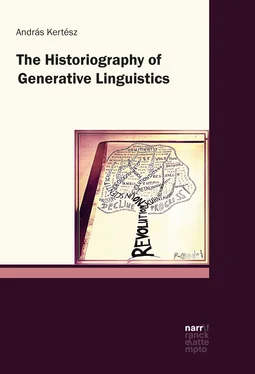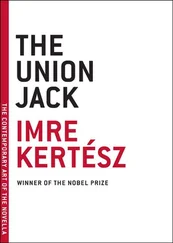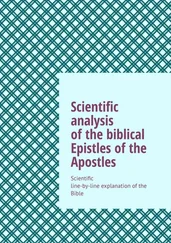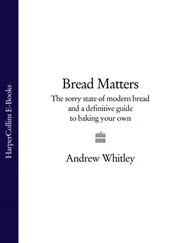| (T1) |
As a result of the ›climate of opinion‹climate of opinion, Syntactic Structures Syntactic Structures triggered a scientificscientific revolutionrevolutionscientific in linguistics in Kuhn’Kuhn, Thomas S.s sense and led to a new paradigm.paradigm4 |
KoernerKoerner, E.F. Konrad supports this claim with two considerations:
First, he argues that while ChomskyChomsky, Noam’s generative linguistics and Saussure’s structuralismstructuralism share common features, the theorytheory that was introduced in Syntactic Structures Syntactic Structures has features which also differ from those of Saussure. KoernerKoerner, E.F. Konrad highlights three elements of Saussure’s view that are, in his opinion, to be found in Chomsky’s work: Saussure’s keen interest in mathematicsmathematical, his rationalism and his psychologism. At the same time, he also analyses the differences which, in his view, support the revolutionaryrevolutionary nature of Chomsky’s theory. He points out that in the works Chomsky published a few years after the appearance of Syntactic Structures , Chomsky emphasizes the dynamic nature of synchrony by referring to Humboldt and stressing the creativity of grammargrammar. Koerner believes that it is due to this dynamism that in a short timeframe Chomsky’s theory had made a great impact, not only on linguistics, but also on sociology and psychology, and this impact led to what KuhnKuhn, Thomas S. would describe as the redefinition of the discipline. In addition, Chomsky further developed Saussure’s categories – above all, later in Aspects Aspects he reinterpreted the Saussurean term of ›langue‹ as ›competence‹. Finally, Chomsky adopted terms from symbolic logiclogic (following primarily Quine, Carnap and Reichenbach) and mathematics (Russell, Whitehead, Shannon and Weaver). Of course, these terms were not at Saussure’s disposal at the beginning of the 20th century.
KoernerKoerner, E.F. Konrad’s second argument is that although Syntactic Structures Syntactic Structures could not remain unaffected by American structuralismstructuralism, it reflected the ›climate of opinionclimate of opinion‹ which was characteristic of the natural sciencesciencenaturals in the 1950s, but which American structuralism was not ready to embrace (Koerner 1978 [1972]: 42; for further discussion, see OteroOtero, Carlos P. 1994). This climate of opinion had the following characteristics:5
as mentioned, the application of the formalformal methods of mathematicsmathematical and symbolic logiclogic to linguistic theorizing;
the primacy of theorytheory over datadata;
following the example of physicalphysics theories, the development of a deductivedeductive theorytheory in linguistics, and the rejection of the methodologymethodology which is restricted to inductiveinductive datadata collection and classification;
the simplicitysimplicity and the eleganceelegance of theorizing as methodological guiding principles;
the pursuit of scientificscientific explanations based on general laws; and
the rejection of the kind of empiricism represented in American structuralismstructuralism.
Accordingly, KoernerKoerner, E.F. Konrad claims that the reason why Syntactic Structures Syntactic Structures was of a revolutionaryrevolutionary nature and resulted in a new paradigmparadigm is not that ChomskyChomsky, Noam created something »ex nihilo« (Koerner 1978: 44), but rather, that he understood and adapted the ›climate of opinionclimate of opinion‹ in a creative and genuine manner; that he was able to apply to linguistics the methodological model of physicsphysics, which was considered the peak of scientificscientific rigor; and that from all these he developed an unprecedented theoretical construct immediately taken up by its adherents.6
Thus KoernerKoerner, E.F. Konrad (1978 [1972]) provides the following solution to the problem (P):
| (SP1) |
The basic terms of the historiographyhistoriography of generative linguistics are ›scientificscientific revolution‹revolutionscientificevolutionscientific and ›paradigm‹paradigm, supplemented by ›climate of opinion‹climate of opinion with respect to Syntactic Structures Syntactic Structures , while its central hypothesis is (T1) and its framework is KuhnKuhn, Thomas S. (1970)[1962]. |
2.1.1.1.2 KuhnianKuhnian revolutionrevolutionKuhnian and linguistic metatheorymetatheory
Keith AllanAllan, Keith’s (2003), (2007) contribution to the historiographyhistoriography of generative linguistics belongs to those which explicitly combine the historical and the philosophical perspective. He takes the KuhnianKuhnian revolutionrevolutionKuhnianaryrevolutionary nature of Syntactic Structures Syntactic Structures for granted, and combines it with the analysis of the relationship between neo-Bloomfieldianneo-BloomfieldianBloomfieldian inductivisminductive and ChomskyChomsky, Noam’s deductivismdeductive. We reconstruct his main claim as follows:
| (T2) |
(a) |
Syntactic Structures Syntactic Structures led to a paradigmparadigm shift in the KuhnianKuhnian sense, from an inductivistinductive paradigm to a hypothetico-deductivistdeductive one whereby the core of Chomsky’Chomsky, Noams revolution is the replacement of discovering grammars by their justification and evaluation. |
|
(b) |
Although a theorytheory of languagelanguage must be a hypothetico-deductivedeductive theory, it also needs inductiveinductive datadata gathering. |
As regards (T2)(a), AllanAllan, Keith (2003: 134ff., 2007: 269ff.) starts his train of thought by reflecting on how the classification of natural objects works. By relying on considerations based both on philosophical insights and the natural sciencesciencenaturals, he concludes that
reality can be perceived only through the constraints and distortions of the physicalphysics and cognitivecognitive structures of human beings,
classifications are based on group-internal conventions, and
scientificscientific theories work along the same lines.
Therefore, there are many possible classifications of natural phenomena and there are no rational grounds to claim that only one of these is the ›truth‹. The same applies to the study of languagelanguage. So, there must be criteria by which one can choose among the possible models of language.
In doing so, two macro-paradigmsparadigm have developed in the course of the historyhistory of linguistics, namely, phenomenological inductivisminductive and hypothetico-deductivismdeductive. In revealing the relationship between these two models, AllanAllan, Keith (2003: 538) uses the term ›paradigm‹ in the sense of KuhnKuhn, Thomas S.:
In the middle of the twentieth century there was a shift from a phenomenological inductivistinductive paradigmparadigm in American linguistics to a hypothetico-deductivistdeductive paradigm; a shift known as ›the ChomskyChomsky, Noam revolutionevolution‹ because it came about through Chomsky’s work. (AllanAllan, Keith 2003: 538; 2007: 284)
As we know, inductivisminductive follows a bottom-up method of reasoning by inferring generalizations from the observation of individual datadata. BloomfieldianBloomfieldian and neo-Bloomfieldianneo-Bloomfieldian linguistics typically applied inductive reasoning.1 Bloomfieldian and neo-Bloomfieldian analyses assumed a hierarchy of levels on the basis of which they proceeded from phones to phonemesphoneme, from phonemes to morphs, from morphs to morphemesmorpheme, and from morphemes to syntactic units.
Hypothetico-deductivismdeductive is the inverse of the inductiveinductive model and follows a top-down reasoning. The latter postulates an abstract theorytheory consisting of general hypotheses and infers from the latter the properties of the individual phenomena it investigates. Thereby, Syntactic Structures Syntactic Structures introduced a hypothetico-deductive model of languagelanguage. ChomskyChomsky, Noam rejected not only induction, but the discovery of grammars as practiced by Zellig S. HarrisHarris, Zellig S. and others as well, and replaced it by the justification and evaluation of grammars.2 It is the latter that AllanAllan, Keith (2003: 547; 2007: 286) calls »[t]he true revolution that Chomsky bequeathed«.
Читать дальше












